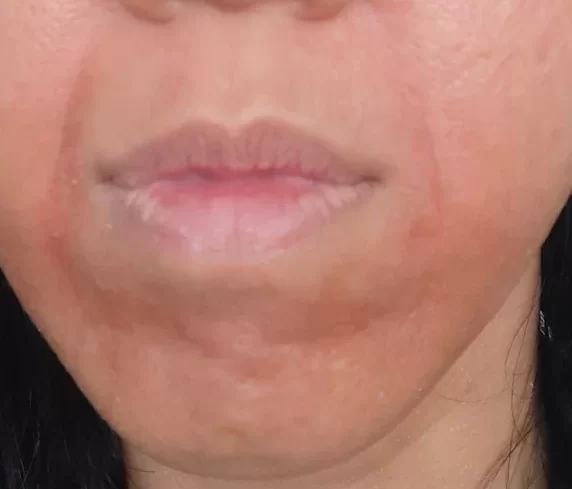Seborrheic dermatitis is a skin condition that most often affects the face, neck, and scalp. The underlying cause is unknown, but it’s thought to be caused by a combination of excess sebum, Malassezia overgrowth, and an abnormal immune response to Malassezia by-products.
Skin conditions can be hard to diagnose as the symptoms can overlap. Seborrheic dermatitis is characterized by redness, scaling and itching in sebum-rich areas. However, SD can affect people differently and range from mild to severe. It can even be accompanied by other skin conditions like psoriasis and rosacea.
Let’s take a deep dive:
What are the symptoms and signs of seborrheic dermatitis?
Seborrheic dermatitis can present quite differently and may vary from person to person. However, there are some characteristics that are typical for SD:
Skin redness
Any inflammation, whether it be due to a reaction to Malassezia, an allergy, or local irritation results in redness. This is caused by dilated and injured blood vessels.
Depending on how severe your SD flare is, the rash can be accompanied by heat (warmth), mild swelling and even weeping.
Itching
SD doesn’t always itch but it often does. When there is an inflammatory response , it is driven by a variety of mediators including cytokines and peptides like Substance P that induces itching. Inflammation also increases blood flow to the skin surface, further aggravating itch.
Try your best not to scratch and this can worsen inflammation and cause more injury to your skin. Scratching can also help spread seb derm to a larger area.

Burning
You’ll often feel that your skin is irritated, even when SD is mild. However, in severe SD, due to distruption of the skin barrier and microscopic wounds from scratching, affected skin can be painful. This is especially so when you wash your face or apply a cream that has irritating ingredients.
Burning often happens during the acute inflammation phase of SD. When the redness settles and scaling happens, the pain often dissipates.
Scaling
After the initial SD flare, you can be left with scaling. These skin flakes may look oily or dry, depending on your skin type. The patches can look reddish on light-colored skin and lighter on darker skin. On the scalp, scaling presents as dandruff.
It may be tempting to pick at the scales or try to scrub them away. I’ve done that myself. Trying to remove scaling aggressively before your skin is healed will only cause more injury to the skin barrier, making your skin raw and painful. In any case, the scales you remove will be replaced by more scales. It’s better to keep your face moisturized and work on your SD internally to improve your symptoms.
Affects sebum-rich areas
Although seborrheic dermatitis can appear in various areas, it tends to occur in areas that contain more sebaceous glands. These areas include:
- scalp (in infants, SD is also known as cradle cap)
- along the hairline
- face – particularly along and between the eyebrows, on the cheeks and in the folds of the skin that run from the nostrils down to the corners of the mouth (nasolabial folds)
- perioral (around the mouth)
- neck
- upper chest
- upper back
Seborrheic dermatitis less commonly may also affect these areas:
- external ear canal
- armpits
- area under the breasts
- groin
Symmetrical distribution
Seborrheic dermatitis is characteristically symmetrical and involves the central third of the face. As the rash gets more severe, it can spread outwards from the center.

Common triggers
There is plenty of factors that can trigger seborrheic dermatitis but some common triggers are those that increase sebum production or reduce immunity:
- humidity
- sweating
- dry or dehydrated skin
- excess oils on skin, especially plant-based oils that feel Malassezia.
- fatigue, especially lack of sleep
- stress
- hormonal effects
Further reading: What triggers seborrheic dermatitis?
How is seborrheic dermatitis diagnosed?
Misdiagnosis of seborrheic dermatitis is a common problem, as it is often mistaken for impetigo, psoriasis, eczema, rosacea or atopic dermatitis. In fact, because my rash started on my forehead and cheeks, sparing my nose and eyes, I thought I had a lupus rash!
However, if your doctor has experience with seborrheic dermatitis and knows the clinical signs to look out for, it can be quite easy to diagnose based on the characteristics I discussed above. There is no need for a biopsy or other more invasive investigations but sometimes a swab may be taken just to make sure there’s no superimposed bacterial infection.
To wrap up
Some people may only experience a few minor symptoms, while others may have more severe cases that require treatment. Regardless, there’s lots you can do to improve seborrheic dermatitis once you have a definite diagnosis. And regardless of what your doctor says, it doesn’t involve steroid creams.



Pingback: Does seborrheic dermatitis hurt?
Pingback: seborrheic dermatitis autoimmune disease
Pingback: seborrheic dermatitis acne
Pingback: Will zinc oxide help seborrheic dermatitis?
Pingback: Vitamin B seborrheic dermatitis
Pingback: iron deficiency seborrheic dermatitis
Pingback: why does seborrheic dermatitis happen
Pingback: Malassezia seborrheic dermatitis
Pingback: witch hazel seborrheic dermatitis
Pingback: seborrheic dermatitis nose
Pingback: is seborrheic dermatitis itchy
Pingback: Seborrheic Dermatitis vs Seborrheic Keratosis
Pingback: seborrheic dermatitis treatment
Pingback: seborrheic dermatitis poor hygiene
Pingback: sunscreen seborrheic dermatitis
Pingback: Psoriasis vs Seborrheic Dermatitis. Or is it Sebopsoriasis?
Pingback: Psoriasis vs Seborrheic Dermatitis: Or is it Sebopsoriasis?
Pingback: seborrheic dermatitis beard
Pingback: seborrheic dermatitis vs eczema